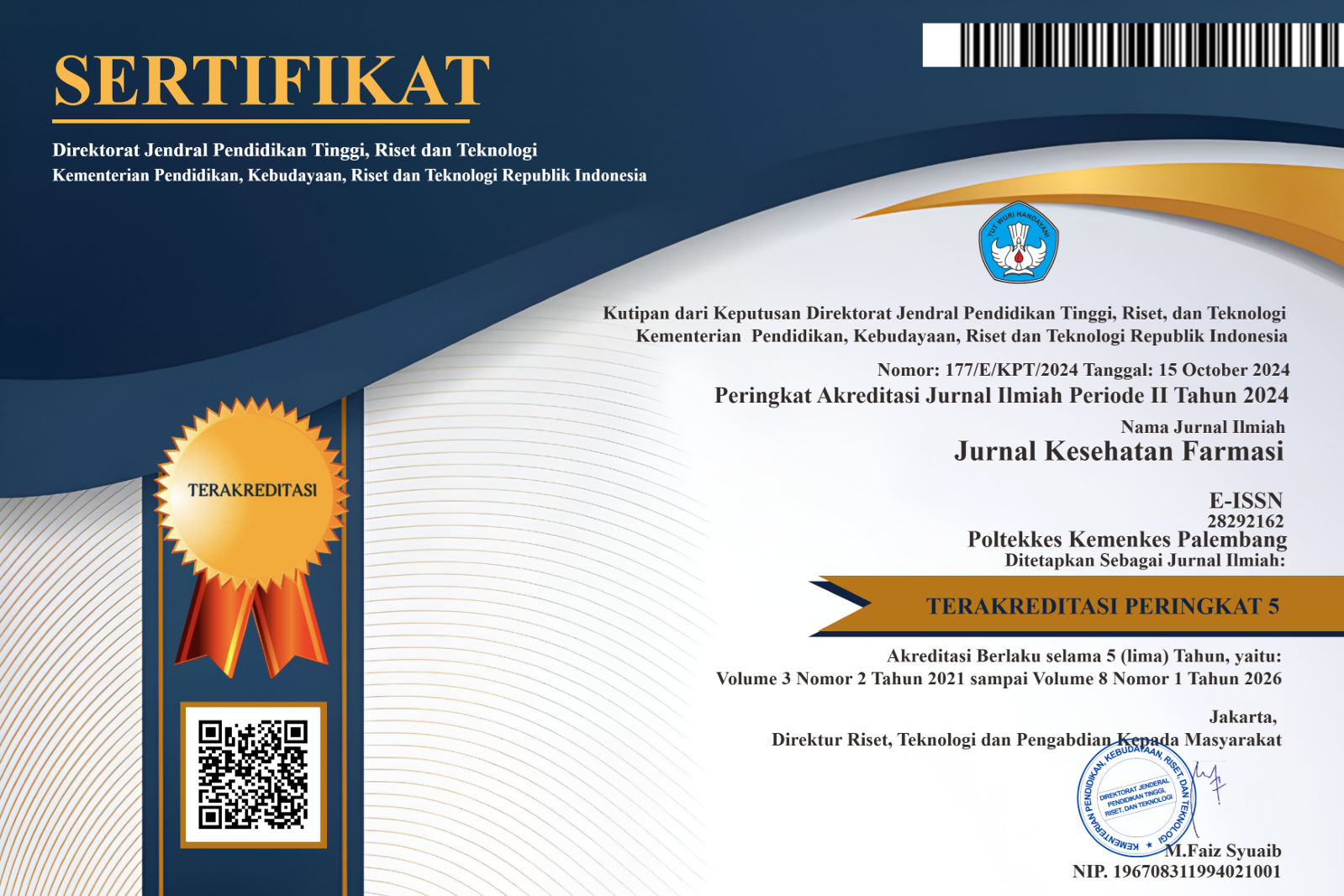Aktivitas Antioksidan Kombinasi Ekstrak Daun dan Kulit Batang Tanaman Kersen (Muntingia calabura L.) Dengan Metode DPPH Secara Spektrofotometri UV-Vis Spectrophotometry
Abstract
ABSTRAK
Latar Belakang : Radikal bebas adalah atom yang memiliki satu atau lebih elektron yang tidak berpasangan sehingga sangat reaktif merusak jaringan akibatnya timbul reaksi oksidatif. Sedangkan antioksidan merupakan senyawa yang mampu menangkal atau meredam dampak negatif oksidan dalam tubuh. Antioksidan bekerja dengan cara mendonorkan satu elektronnya kepada senyawa yang bersifat oksidan sehingga aktivitas senyawa oksidan tersbut bisa dihambat. Tanaman Kersen terbukti mengandung senyawa flavonoid,Oleh karena itu, dilakukan penelitian mengenai aktivitas antioksidan yang terdapat pada daun dan Kulit Batang tanaman kersen yang di kombinasi.
Metode Penelitian : Penelitian ini merupakan penelitian deskriptif analitik. deskriptif dengan melakukan uji aktivitas antioksidan yang terdapat pada kombinasi ekstrak etanol daun kersen dan kulit batang tanaman kersen (Muntingia Calabura. L) terhadap peredaman radikal bebas DPPH secara spektrofotometri UV-Vis, dilanjutkan dengan penentuan IC50.
Hasil : Rendemen yang diperoleh dari ekstrak Kombinasi daun dan kulit batang tanamn kersen yaitu 3,347% Hasil penelitian menunjukan nilai IC50 ekstrak kombinasi daun dan ulit batang tanaman kersen yaitu 11,1481 ppm. Sedangkan nilai IC50 kontrol (+) Vitamin C yaitu 6,4665 ppm.
Kesimpulan : Penelitian ini menunjukan bahwa ekstrak kombinasi daun dan kulit batang tanaman kersen memiliki aktifitas antioksidan yang lebih kuat jika dibandingkan dengan bentuk tunggalnya. Dan lebih kecil jika di bandingkan dengan kontrol (+) Vitamin C
Kata kunci : Antioksidan, Radikal Bebas, Tanaman Kersen
ABSTRACT
Background: Free radicals are atoms that have one or more unpaired electrons so that they are very reactive and damage the network as a result of oxidative reactions. Meanwhile, antioxidants are compounds that can counteract or reduce the negative impact of oxidants in the body. Antioxidants work by donating one electron to an oxidant compound so that the activity of the oxidant compound can be inhibited.Kersen plants are proven to contain flavonoid compounds. Therefore, a study was conducted on the antioxidant activity found in the leaves and bark of cherry plants in combination.
Methods: This research is a descriptive analytic study. descriptive by carrying out the antioxidant activity test contained in the combination of ethanol extract of cherry leaves and bark of cherry plants (Muntingia Calabura. L) against DPPH free radical reduction by UV-Vis spectrophotometry, followed by the determination of IC50.
Results: The yield obtained from the combination extract of leaves and bark of cherry plants was 3.347%. The results showed that the IC50 value of the combination of leaves and stem extract of cherry plants was 11.1481 ppm. Meanwhile, the control IC50 (+) value of Vitamin C was 6.4665 ppm.
Conclusion: This study shows that the combined extract of the leaves and bark of the cherry plant has stronger antioxidant activity when compared to its single form. And smaller when compared to control (+) Vitamin C
Keywords : Antioxidants, Free Radicals, Kersen Plants
Copyright (c) 2021 JKPharm Jurnal Kesehatan Farmasi

This work is licensed under a Creative Commons Attribution-ShareAlike 4.0 International License.
Authors who publish with this journal agree to the following terms:
- Authors retain copyright and grant the journal right of first publication with the work simultaneously licensed under a Creative Commons Attribution License that allows others to share the work with an acknowledgement of the work's authorship and initial publication in this journal.
- Authors are able to enter into separate, additional contractual arrangements for the non-exclusive distribution of the journal's published version of the work (e.g., post it to an institutional repository or publish it in a book), with an acknowledgement of its initial publication in this journal.
- Authors are permitted and encouraged to post their work online (e.g., in institutional repositories or on their website) prior to and during the submission process, as it can lead to productive exchanges, as well as earlier and greater citation of published work














